Lenovo on Wednesday launched four new laptops under its Yoga
lineup in India, starting from Rs. 30,490. The convertible laptops launched are
the Lenovo Yoga 300, Lenovo Yoga 500, Lenovo Yoga 3 14, and the Lenovo Yoga 3
Pro.
As for availability, all the four Windows 8.1-based laptops
are already available to buy from the company's own thedostore.com. In terms of
pricing, the Yoga 300 costs Rs. 30,490, the Yoga 500, Yoga 3 14 and Yoga 3 Pro
are priced at Rs. 71,490, Rs. 86,990, Rs. 1,15,990 respectively. The laptops
displays can also be flipped 360 degrees and be used in laptop, stand, tent,
and tablet modes.
The Yoga 300 (seen above) features a 11.6-inch HD (720x1280
pixels) LED-backlit multi-touch display and is powered by 64-bit Intel Pentium
N3540p rocessor (4 cores, 4 threads, 2.16GHz base clock, up to 2.66GHz burst,
2MB cache) clubbed with 4GB of DDR3L 1333MHz RAM and Intel integrated graphics.
Besides a 720p HD camera with single mic, the convertible laptop includes a
500GB HDD clocked at 5400RPM. The connectivity features of the laptop include
Wi-Fi, Bluetooth, USB 2.0, USB 3.0, and HDMI. The device's audio is powered by
Dolby Home Theatre technology and can run up to 8 hours on single charge.
Notably, it does not feature an optical disc drive. It is powered by a 2-cell
30Wh battery, and will be available in a White colour variant.
The Lenovo Yoga 500 (seen above) features a 14-inch full-HD
(1080x1920 pixels) IPS multi-touch display and is powered by fifth generation
64-bit Intel Core i7-5500U processor (2 cores, 4 threads, 2.4GHz base clock, up
to 3GHz burst, 4MB cache) clubbed with 8GB of DDR3L 1600MHz RAM and Intel
integrated graphics along with the Nvidia GeForce 920M (N16V-GM) GPU with 2GB
of DDR3L RAM. Besides a 720p HD camera with array mic, the laptop includes a
1TB SSHD. The connectivity features of the laptop include Wi-Fi, Bluetooth, USB
2.0, USB 3.0, HDMI, and a headphone and mic combo jack. It will be available in
Black and White colour variants. Like the Yoga 300, the Yoga 500 also does not
sport an optical disc drive, and is powered by a 3-cell 45Wh battery.
The Yoga 3 14 (seen above) features a 14-inch full-HD
(1080x1920 pixels) IPS multi-touch display, and is powered by the same
processor and RAM seen on with Yoga 500. It sports a dedicated Nvdia GeForce
940M (N16S-GT) GPU with 2GB of GDDR3 RAM. The device features a 720p HD camera
and comes with a 256GB SSD. The connectivity features of the laptop include
Wi-Fi, Bluetooth, USB 2.0, USB 3.0, HDMI, and a headphone and mic combo jack.
Powered by a 4-cell 45Wh battery, it too doesn't bear an optical disc drive,
and will be available in Silver colour.
Lastly, the Lenovo Ideapad Yoga 3 Pro (seen above) features
a 13.3-inch QHD+ (1800x3200 pixels) IPS multi-touch display and is powered by a
64-bit Intel Core M-5Y71 processor (2 cores, 4 threads, 1.2GHz base clock, up
to 2.9GHz burst, 4MB cache) clubbed with 8GB of DDR3L 1600MHz RAM and Intel's
integrated graphics. The laptop sports a 512GB SSD and bears a 720p HD camera.
The device's audio section is powered by JBL and Waves Audio and can run up to
7.2 hours on single charge on its 4-cell 44.8Wh battery. It will be available
in Champagne Gold colour. Unlike the other three laptops launched, the Yoga 3
PRO runs Windows 8.1 EM (for emerging markets).
"Globally we are the leaders in the consumer
convertible PC space. We achieved this by constantly innovating and stretching
the boundaries of what a PC stands for. The Yoga franchise is the
representation of this consumer-centric design and engineering. We are happy to
make the Yoga franchise, through this new line of products, accessible to a
much wider audience," said Bhaskar Choudhuri, Director - Marketing, Lenovo
India during the launch.
Source From;- http://gadgets.ndtv.com/





















